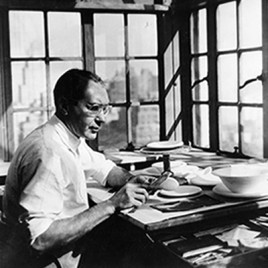Pioneer Information
Wright was born in Lebanon, Ohio, and studied at the Art Academy of Cincinnati as a high school student. He attended the Arts Student League of New York for a year before enrolling at Princeton University, which he attended from 1922 to 1924, gravitating towards theatrical set design. After leaving college he worked as a theater set designer with Norman Bel Geddes. In 1927 he met and married Mary Small Einstein, who became his business partner and encouraged him to design useful objects. Wright participated in an exhibition of Contemporary American Industrial Art at New York’s Metropolitan Museum of Art in 1931 and in 1935 established Russel Wright Associates with Irving Richards. By the late 1930s Wright was a well-known and prolific designer of objects for the home, including furniture, appliances, textiles, and dinnerware. Through his elegant and functional designs, particularly his enormously popular American Modern line of dinnerware, he brought modernism to millions of Americans.
In 1942 Russel and Mary Wright purchased a 75-acre abandoned quarry and logging site in Garrison, New York, which the couple named Manitoga. Over the next 34 years Wright developed the site as a home, studio, and “woodland garden.”
In 1950 the Wrights published, Guide to Easier Living , which encouraged Americans to embrace simple and comfortable lifestyles. In 1955, three years after his wife’s death, Wright was engaged by the U.S State Department and traveled to Southeast Asia to research handicraft industries. Wright served as the primary architect on to the development of the Summer in the Parks (1968-1976) program for the National Park Service, which connected people to parks in and around the nation’s capital through art and recreation. Wright died in New York City in 1976.







